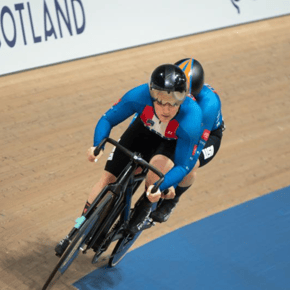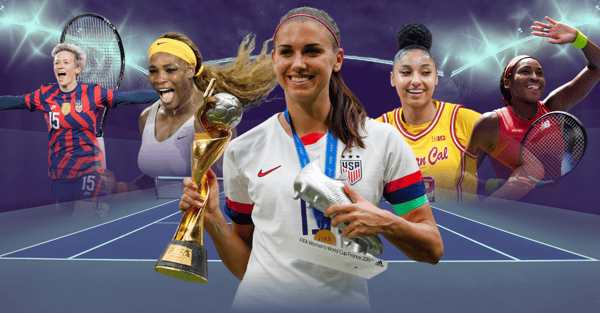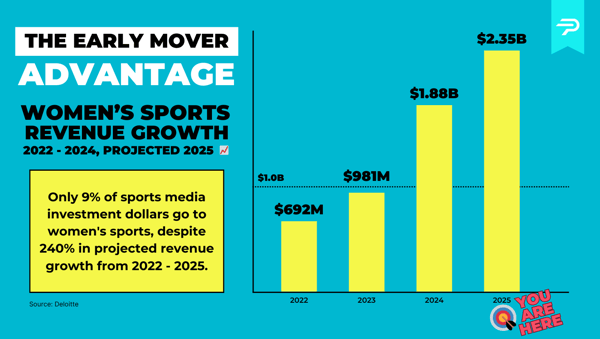
Skyler Samuelson Espinoza exults after she and tandem cyclist teammate Hannah Chadwick complete a race at the 2023 Parapan American Games. Photo by Pablo Bigorra/Parapanamericanos via Photosport
I was in my first year of college, and sitting in my Russian literature class next to a beautiful woman who looked maybe a bit older than me. She introduced herself as Alex, which didn’t ring any bells, but I was sure I knew her from somewhere. She explained she’d recently retired. Retired? From what? And then it clicked. Sasha Cohen was sitting next to me in my literature class. Silver medallist figure skater Sasha (Alexandra) Cohen. At 18, it felt so crazy to me that someone could be retired and sitting in a freshman level college course. Wasn’t retiring for, like…old people?
Fast forward 12 years, and I, too, am a retiree; just about as old now as Sasha was then.
Not long after meeting Sasha/Alex, I decided to walk on to the Columbia/Barnard Women’s Rowing Team. I fell in love with the water and sweat and blisters, and knew that I would turn sports into my career someday. While a back surgery ended my rowing career, I wasn’t ready to give up on the dream just yet. I wanted what Sasha had, the highest peak of any athlete’s career: I wanted to be an Olympian.
When I started to ride my bike competitively, it was with the sole goal of making it to the Games. I don’t even really love riding my bike. I liked it well enough, but it wasn’t the bike riding that was getting me up and outside every day, rain or shine. The light at the end of the tunnel was the iconic 5 rings, and whatever I had to do to get there I would do.
.jpeg?width=1200&height=630&name=Espinoza_USATeamphotos_ParaTrackWorlds080723-017%20(2).jpeg) Source: Team USA
Source: Team USA
This path was so much more difficult than I imagined it would be, because it was hard in ways that I couldn’t have imagined. The hard parts, for me, were not getting up early or working out hard. It was never eating a strict diet or missing out on family functions that tested me. It was the uncertainty, the months of travel, the stress the journey puts on relationships and finances: the stuff that no one talks about but which is such a crucial part of a career in sports.
So. As the path towards the Games came into focus, I knew I wanted to shoot for 2024, and only 2024. Whether I achieved my goal or didn’t, I knew I would take at least an extended break afterwards, if not retire completely. This is absolutely not the case for everyone. For many people, if the Games are a goal, they will train and compete as long as they are able to try to achieve it. It’s different for everyone. Those people astound me, and I’m so, so impressed by them.
But as 2024 approached and the chances of making the Games seemed ever less likely, I didn’t waver in my commitment to retirement afterwards: there wasn’t going to be a second shot at this goal, not for me.
Lots of people around me didn’t believe me, especially my coach. She insisted that I would feel differently after I did (or didn’t) go to the Games, and there was always the background expectation that even if I went to the Paralympic Games with my tandem partner Hannah, that I would try for another cycle to go to the Olympic Games on my own. A lot of people around me, before me and after me, have struggled to let go of sport. So I was getting a lot of “you’re going to miss this!” and, “A couple of months on the couch then you’ll be right back!” “What about LA? It’s a home Games! Four more years is nothing in the grand scheme of your life!”
I would smile and say, “You never know!” But I did know. I was sure. I was sure I wouldn’t want to come back after a few months. I knew I would miss parts of it, but I would enjoy my life beyond sports more.
And I was right. I love my new life, and I feel even more sure now than I did before that retirement from sports was the right choice for me.
 The pair took gold at the Parapan American Games in Santiago, Chile. Photo by Courtesy of / Joe Kusumoto/USOPC
The pair took gold at the Parapan American Games in Santiago, Chile. Photo by Courtesy of / Joe Kusumoto/USOPC
That doesn’t mean that it hasn’t been a transition, and that there aren’t parts of that transition that have been harder than others. Folding up race day uniforms that I’ll likely never wear again mere weeks after wearing them at the biggest competition of my life is a bit of a startling process. I didn’t go half time before my retirement, none of my friends are retiring and I recently moved to a new country. Some days it feels like I just shut the door completely on my athletic career so now have moments when I have an uncanny sense of self-doubt: did that really happen?
While I may not be kitting up any time soon, the physical pieces of an athletic career are some of the things that help me remember. There are medals and t-shirts, lanyards and pins, swag and race numbers, an extra special plane ticket and good luck sports bra. While most of these things I’ll keep for the rest of my life, I recently made the choice to sell a few items in the Parity Locker. I’ve been involved with Parity in a number of different capacities, and, each time, I’m so impressed by how they treat athletes. Parity is working so hard to make female athletes feel seen, valued and respected, and the Parity Locker is a really cool extension of that. Sports merchandise is such a huge part of men’s sports fandom, and the Parity Locker is the first platform of its kind to sell women’s memorabilia exclusively.
Seeing my items for sale in the Parity Locker makes me remember again that I did that, and my career in professional sports wasn’t only a passion project or a hobby: it was a career. Getting to have my jerseys sold on the same platform as other Team USA athletes makes me feel proud to have been an athlete, and proud to play a small part in the fight to advance women’s sports. Selling my gear through Parity feels right, because I’m honoring myself while also supporting an organization I care so deeply about.
So. Whether you’re a retiree at 25 or 65 or 85, I hope that you have the chance that I have had to look back on your journey and realize it didn’t bring value only to your life, but to the lives of others. We spend so much of our time looking forward, that often we can lose track of where we’ve been. I closed a big door in my life very quickly, and without much fanfare.
I’m so grateful to Parity for helping me celebrate the end of this big chapter, and giving me the opportunity to look back on it with joy and pride.
About Parity, a Group 1001 Company
Minority-founded in 2020, Parity's mission is to close the gender income and opportunity gap in professional sports. By developing high-impact collaborations between brands, professional women athletes and their fans, Parity has proudly put more than $3.5 million in the pockets of women athletes, attracting dozens of brands to the movement in the process. The platform offers connections to more than 1000 women athletes from 80+ sports, including well over 200 Olympians and Paralympians. For more information on how to tap into the rapidly rising influence and popularity of women athletes, visit https://paritynow.co or follow us on Instagram, LinkedIn, Facebook, and Threads.




